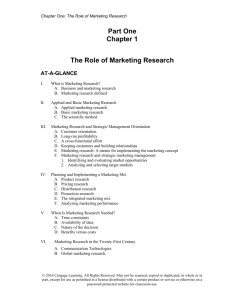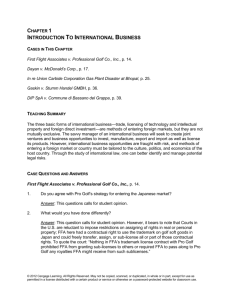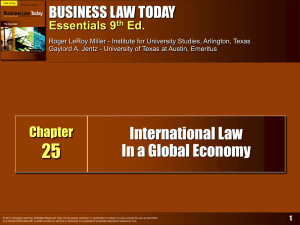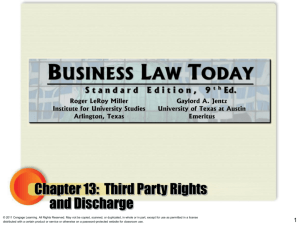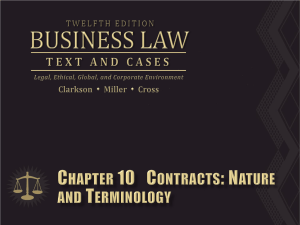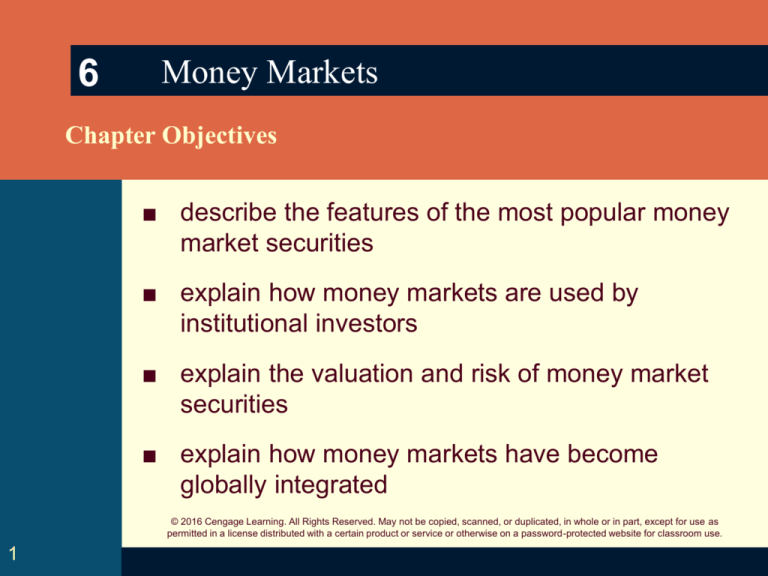
6
Money Markets
Chapter Objectives
■ describe the features of the most popular money
market securities
■ explain how money markets are used by
institutional investors
■ explain the valuation and risk of money market
securities
■ explain how money markets have become
globally integrated
© 2016 Cengage Learning. All Rights Reserved. May not be copied, scanned, or duplicated, in whole or in part, except for use as
permitted in a license distributed with a certain product or service or otherwise on a password-protected website for classroom use.
1
Money Market Securities
Money market securities are debt securities with a maturity of
one year or less.
Issued in the primary market through a telecommunications
network by the Treasury, corporations, and financial
intermediaries that wish to obtain short-term financing.
Are commonly purchased by households, corporations, and
governments that have funds available for a short time period.
Can be sold in the secondary market and are liquid.
2
© 2016 Cengage Learning. All Rights Reserved. May not be copied, scanned, or duplicated, in whole or in part, except for use as
permitted in a license distributed with a certain product or service or otherwise on a password-protected website for classroom use.
Money Market Securities
The more popular money market securities are:
3
Treasury bills (T-bills)
Commercial paper
Negotiable certificates of deposit
Repurchase agreements
Federal funds
Banker’s acceptances
© 2016 Cengage Learning. All Rights Reserved. May not be copied, scanned, or duplicated, in whole or in part, except for use as
permitted in a license distributed with a certain product or service or otherwise on a password-protected website for classroom use.
Money Market Securities
Treasury Bills
4
Issued when the U.S. government needs to borrow funds.
The Treasury issues T-bills with 4-week, 13-week, and 26week maturities on a weekly basis, with terms shorter than 4week periodically, with a 1-year maturity on a monthly basis.
The par value (amount received by investors at maturity) of Tbills was historically a minimum of $10,000, but now it is
$1,000 and multiples of $1,000.
Are sold at a discount from par value, and the gain is the
difference between par value and the price paid
Backed by the federal government and are virtually free of
credit (default) risk.
Highly liquid, due to short maturity and strong secondary
market.
© 2016 Cengage Learning. All Rights Reserved. May not be copied, scanned, or duplicated, in whole or in part, except for use as
permitted in a license distributed with a certain product or service or otherwise on a password-protected website for classroom use.
Money Market Securities
Treasury Bills (cont.)
Investors in Treasury Bills
5
Depository institutions
Other financial institutions
Individuals with substantial savings invest indirectly through
money market funds.
Corporations
© 2016 Cengage Learning. All Rights Reserved. May not be copied, scanned, or duplicated, in whole or in part, except for use as
permitted in a license distributed with a certain product or service or otherwise on a password-protected website for classroom use.
Money Market Securities
Treasury Bills (cont.)
Pricing Treasury Bills
Priced at a discount from their par value
Price depends on the investor’s required rate of return
Value of a T-bill is the present value of the par value
Example: If investors require a 4 percent annualized return on a
one-year T-bill with a $10,000 par value, the price that they are
willing to pay is:
P = $10,000 / (1.04)
P = $9,615.38
6
© 2016 Cengage Learning. All Rights Reserved. May not be copied, scanned, or duplicated, in whole or in part, except for use as
permitted in a license distributed with a certain product or service or otherwise on a password-protected website for classroom use.
Another example
Example: If investors require a 4 percent annualized return on a
6-month T-bill with a $10,000 par value, the price that they are
willing to pay is:
P = $10,000 / (1.02)
P = $9,803.92
7
© 2016 Cengage Learning. All Rights Reserved. May not be copied, scanned, or duplicated, in whole or in part, except for use as
permitted in a license distributed with a certain product or service or otherwise on a password-protected website for classroom use.
Money Market Securities
Treasury Bills (cont.)
Estimating the Yield (annualized)
SP PP 365
PP
n
where
YT
SP selling price
PP purchase price
n number of days of the investment (holding period)
This formula is used for investors who hold the T-bill until maturity or sell
it before maturity.
8
© 2016 Cengage Learning. All Rights Reserved. May not be copied, scanned, or duplicated, in whole or in part, except for use as
permitted in a license distributed with a certain product or service or otherwise on a password-protected website for classroom use.
T-bill yield examples
1. An investor purchased a T-bill with a 6-month(182 days)
maturity and $10,000 par value for $9,800. If this T-bill is
held until maturity, its yield is:
YT
10000 9800 365
4.09%
9800
182
2. Suppose the investor plans to sell the T-bill after 120
days and forecasts a selling price of $9,950 at that time.
The expected annualized yield is
YT
9
9950 9800 365
4.66%
9800
120
© 2016 Cengage Learning. All Rights Reserved. May not be copied, scanned, or duplicated, in whole or in part, except for use as
permitted in a license distributed with a certain product or service or otherwise on a password-protected website for classroom use.
Money Market Securities
Treasury Bills (cont.)
Estimating the Treasury Bill Discount
Par PP 360
YT
Par
n
This formula is usually used for the newly issued T-bills. It represents the
percentage discount of the purchasing price from par value.
10
© 2016 Cengage Learning. All Rights Reserved. May not be copied, scanned, or duplicated, in whole or in part, except for use as
permitted in a license distributed with a certain product or service or otherwise on a password-protected website for classroom use.
Treasury bill discount example
1. If a newly issued 6-month (182-day) T-bill with a par
value of $10,000 is purchased for $9,800, the T-bill
discount is
YT
11
10000 9800 360
3.956%
10000
182
© 2016 Cengage Learning. All Rights Reserved. May not be copied, scanned, or duplicated, in whole or in part, except for use as
permitted in a license distributed with a certain product or service or otherwise on a password-protected website for classroom use.
Money Market Securities
Treasury Bill Auction
Investors can submit bids online for newly issued
T-bills at www.treasurydirect.gov.
Select maturity and face value.
bidding competitively vs. noncompetitively (limit of
5 mil).
12
© 2016 Cengage Learning. All Rights Reserved. May not be copied, scanned, or duplicated, in whole or in part, except for use as
permitted in a license distributed with a certain product or service or otherwise on a password-protected website for classroom use.
Money Market Securities
Commercial Paper
Short-term debt instrument issued by well-known, creditworthy
firms and is typically unsecured.
Normally issued to provide liquidity or to finance a firm’s
investment in inventory and accounts receivable.
The minimum denomination of commercial paper is usually
$100,000.
Maturities are normally between 20 and 45 days but can be as
short as 1 day or as long as 270 days.
13
© 2016 Cengage Learning. All Rights Reserved. May not be copied, scanned, or duplicated, in whole or in part, except for use as
permitted in a license distributed with a certain product or service or otherwise on a password-protected website for classroom use.
Money Market Securities
Commercial Paper (cont.)
Denomination
Credit Risk
14
The minimum denomination of commercial paper is usually
$100,000.
Risk is affected by issuer’s financial condition and cash flow.
© 2016 Cengage Learning. All Rights Reserved. May not be copied, scanned, or duplicated, in whole or in part, except for use as
permitted in a license distributed with a certain product or service or otherwise on a password-protected website for classroom use.
Money Market Securities
Commercial Paper (cont.)
Credit Risk Ratings
Assigned by rating agencies such as Moody’s Investors Service,
Standard & Poor’s Corporation, and Fitch Investor Service.
Serves as an indicator of the potential risk of default.
Higher credit ratings suggest lower expectancy of credit
default. (Exhibit 6.2)
15
© 2016 Cengage Learning. All Rights Reserved. May not be copied, scanned, or duplicated, in whole or in part, except for use as
permitted in a license distributed with a certain product or service or otherwise on a password-protected website for classroom use.
Exhibit 6.2 Possible Ratings Assigned to Commercial
Paper
16
© 2016 Cengage Learning. All Rights Reserved. May not be copied, scanned, or duplicated, in whole or in part, except for use as
permitted in a license distributed with a certain product or service or otherwise on a password-protected website for classroom use.
Money Market Securities
Commercial Paper (cont.)
Placement
Firms place commercial paper directly with investors or rely on
commercial paper dealers to sell their commercial paper.
Backing Commercial Paper
Some backed by assets of the issuer and offers lower yield than
unsecured commercial paper.
Estimating the Yield
Commercial paper does not pay interest and is priced at a discount
from par value.
The yield on commercial paper is higher than the yield on a T-bill
with the same maturity because of credit risk and less liquidity.
17
© 2016 Cengage Learning. All Rights Reserved. May not be copied, scanned, or duplicated, in whole or in part, except for use as
permitted in a license distributed with a certain product or service or otherwise on a password-protected website for classroom use.
Commercial paper yield example
1. If an investor purchases 30 day commercial paper with a
par value of $1,000,000 for a price of $996,000, and
holds it until maturity, the yield is
YT
18
1,000,000 996,000 360
4.82%
996,000
30
© 2016 Cengage Learning. All Rights Reserved. May not be copied, scanned, or duplicated, in whole or in part, except for use as
permitted in a license distributed with a certain product or service or otherwise on a password-protected website for classroom use.
Money Market Securities
Negotiable Certificates of Deposit
Certificates issued by large commercial banks and other
depository institutions as a short-term source of funds.
The minimum denomination is $100,000.
Maturities on NCDs normally range from two weeks to one
year.
A secondary market for NCDs exists, providing investors with
some liquidity.
19
© 2016 Cengage Learning. All Rights Reserved. May not be copied, scanned, or duplicated, in whole or in part, except for use as
permitted in a license distributed with a certain product or service or otherwise on a password-protected website for classroom use.
Money Market Securities
Negotiable Certificates of Deposit (cont.)
Placement
Some issuers place their NCDs directly; others use a dealer that
specializes in placing NCDs.
Yield
YNCD
SP PP interest
PP
Offer a premium above the T-bill yield in order to compensate for
less liquidity and safety.
20
© 2016 Cengage Learning. All Rights Reserved. May not be copied, scanned, or duplicated, in whole or in part, except for use as
permitted in a license distributed with a certain product or service or otherwise on a password-protected website for classroom use.
NCD yield example
1. An investor purchased an NCD a year ago for $990,000,
He redeems it today upon maturity and receives
$1,000,000. he also received interest of $40,000. His
annualized yield is
YNCD
21
1,000,000 990,000 40,000
5.05%
990,000
© 2016 Cengage Learning. All Rights Reserved. May not be copied, scanned, or duplicated, in whole or in part, except for use as
permitted in a license distributed with a certain product or service or otherwise on a password-protected website for classroom use.
Money Market Securities
Repurchase Agreements
With a repurchase agreement (repo), one party sells securities to
another with an agreement to repurchase the securities at a
specified date and price.
A reverse repo is the purchase of securities by one party with
an agreement to sell them.
A repurchase agreement (or repo) represents a loan backed by
the securities.
Financial institutions often participate in repos.
Transaction amounts are usually for $10 million or more.
The most common maturities are from 1 day to 15 days and for
one, three, and six months.
22
© 2016 Cengage Learning. All Rights Reserved. May not be copied, scanned, or duplicated, in whole or in part, except for use as
permitted in a license distributed with a certain product or service or otherwise on a password-protected website for classroom use.
Money Market Securities
Repurchase Agreements
Placement
Negotiated through a telecommunications network.
Dealers and repo brokers act as financial intermediaries to create
repos for firms with deficient or excess funds, receiving a
commission for their services.
Estimating the Yield
SP PP 360
Repo rate
PP
n
23
© 2016 Cengage Learning. All Rights Reserved. May not be copied, scanned, or duplicated, in whole or in part, except for use as
permitted in a license distributed with a certain product or service or otherwise on a password-protected website for classroom use.
Money Market Securities
Federal Funds
Enables depository institutions to lend or borrow short-term
funds from each other at the federal funds rate.
The rate is normally slightly higher than the T-bill rate at any
given time.
Commercial banks are the most active participants.
The volume of interbank loans on commercial bank balance
sheets over time is an indication of the importance of lending
between depository institutions.
24
© 2016 Cengage Learning. All Rights Reserved. May not be copied, scanned, or duplicated, in whole or in part, except for use as
permitted in a license distributed with a certain product or service or otherwise on a password-protected website for classroom use.
Money Market Securities
Banker’s Acceptances (Exhibit 6.5)
Indicates that a bank accepts responsibility for a future
payment.
Commonly used for international trade transactions.
Exporters can hold a banker’s acceptance until the date at which
payment is to be made, but they frequently sell the acceptance
before then at a discount to obtain cash immediately.
Because acceptances are often discounted and sold by the
exporting firm prior to maturity, an active secondary market
exists.
Steps Involved in Banker’s Acceptances (Exhibit 6.4)
25
© 2016 Cengage Learning. All Rights Reserved. May not be copied, scanned, or duplicated, in whole or in part, except for use as
permitted in a license distributed with a certain product or service or otherwise on a password-protected website for classroom use.
Exhibit 6.4 Sequence of Steps in the Creation of a
Banker’s Acceptance
26
© 2016 Cengage Learning. All Rights Reserved. May not be copied, scanned, or duplicated, in whole or in part, except for use as
permitted in a license distributed with a certain product or service or otherwise on a password-protected website for classroom use.
Exhibit 6.5 Survey of Commonly Issued Money
Market Securities
27
© 2016 Cengage Learning. All Rights Reserved. May not be copied, scanned, or duplicated, in whole or in part, except for use as
permitted in a license distributed with a certain product or service or otherwise on a password-protected website for classroom use.
Institutional Use of Money Markets
Financial institutions purchase money market securities in order
to earn a return while maintaining adequate liquidity.
Money market securities can be used to enhance liquidity in two
ways.
•
Newly issued securities generate cash.
•
Purchased money market securities will generate cash upon
liquidation.
Financial institutions that purchase money market securities are
acting as creditors to the initial issuers of the securities.
28
© 2016 Cengage Learning. All Rights Reserved. May not be copied, scanned, or duplicated, in whole or in part, except for use as
permitted in a license distributed with a certain product or service or otherwise on a password-protected website for classroom use.
Valuation of Money Market Securities
Market Price of Money Market Security (Pm)
Par
(1 k ) n
where Par par value or principal amount to be provided at maturity
k required rate of return by investors
n time to maturity
Pm
A change in Pm can be modeled as:
P m f (k )and k f (R f , RP )
where R f risk - free interest rate
RP risk premium
29
© 2016 Cengage Learning. All Rights Reserved. May not be copied, scanned, or duplicated, in whole or in part, except for use as
permitted in a license distributed with a certain product or service or otherwise on a password-protected website for classroom use.
Valuation of Money Market Securities
Impact of Changes in Credit Risk
Credit risk following Lehman’s default
Institutional investors were less willing to invest in commercial
paper because of concerns that other firms might default. As a
result, many firms were no longer able to rely on the commercial
paper market for short-term funding.
30
In November 2008, the Fed began to purchase commercial paper
issued by highly rated firms to increase liquidity in the commercial
paper market.
© 2016 Cengage Learning. All Rights Reserved. May not be copied, scanned, or duplicated, in whole or in part, except for use as
permitted in a license distributed with a certain product or service or otherwise on a password-protected website for classroom use.
Exhibit 6.8 Value of Commercial Paper Outstanding
over Time
31
© 2016 Cengage Learning. All Rights Reserved. May not be copied, scanned, or duplicated, in whole or in part, except for use as
permitted in a license distributed with a certain product or service or otherwise on a password-protected website for classroom use.
Exhibit 6.9 Money Market Yields over Time
(Annualized Yields, One-Month Maturity)
32
© 2016 Cengage Learning. All Rights Reserved. May not be copied, scanned, or duplicated, in whole or in part, except for use as
permitted in a license distributed with a certain product or service or otherwise on a password-protected website for classroom use.
Valuation of Money Market Securities
Interest Rate Risk
If short-term interest rates increase, the required rate of
return on money market securities will increase and the
prices of money market securities will decrease.
An increase in interest rates is not as harmful to a money
market security as it is to a longer term bond.
Measuring Interest Rate Risk
33
Participants in the money markets can use sensitivity analysis to
determine how the value of money market securities may change
in response to a change in interest rates.
© 2016 Cengage Learning. All Rights Reserved. May not be copied, scanned, or duplicated, in whole or in part, except for use as
permitted in a license distributed with a certain product or service or otherwise on a password-protected website for classroom use.
Exhibit 6.10 Probability Distribution of Proceeds from
Selling Money Market Securities
34
© 2016 Cengage Learning. All Rights Reserved. May not be copied, scanned, or duplicated, in whole or in part, except for use as
permitted in a license distributed with a certain product or service or otherwise on a password-protected website for classroom use.
Globalization of Money Markets
Eurodollar Securities: dollar deposits in Europe
Eurodollar CDs - large, dollar-denominated deposits (such as $1
million) accepted by banks in Europe.
Euronotes - short-term securities issued in bearer form with common
maturities of one, three, and six months.
Euro-commercial paper - issued without the backing of a banking
syndicate.
International Interbank Market - facilitates the transfer of
funds from banks with excess funds to those with deficient
funds.
35
LIBOR
© 2016 Cengage Learning. All Rights Reserved. May not be copied, scanned, or duplicated, in whole or in part, except for use as
permitted in a license distributed with a certain product or service or otherwise on a password-protected website for classroom use.
Globalization of Money Markets
Performance of Foreign Money Market Securities
Measured by the effective yield (adjusted for the exchange rate)
Ye (1 Y f ) (1 %S ) 1
Yf
SPf PPf
PPf
where SPf selling price of the foreign money market security
in the foreign currency
PPf purchase price of the foreign money market security
in the foreign currency
% S
36
measures the percentage change in the spot exchange rate (in dollar)
© 2016 Cengage Learning. All Rights Reserved. May not be copied, scanned, or duplicated, in whole or in part, except for use as
permitted in a license distributed with a certain product or service or otherwise on a password-protected website for classroom use.
Yield in foreign money market
1. A US investor obtains Mexican pesos when the peso is
worth $0.12 and invests in a one-year money market
security that provides a yield (in pesos) of 22%. At the
end of one year, the investor coverts the proceeds back
to dollars at $0.13 per peso. The peso increased in
value by 8.33%. The effective yield is
Ye (1 Y f ) (1 % S ) 1
1.22 (1 0.0833) 1
32.16%
37
© 2016 Cengage Learning. All Rights Reserved. May not be copied, scanned, or duplicated, in whole or in part, except for use as
permitted in a license distributed with a certain product or service or otherwise on a password-protected website for classroom use.
Homework assignment 5
1. Chapter 6 problems: 1,2,3,4,5,6,7,8,10.
38
© 2016 Cengage Learning. All Rights Reserved. May not be copied, scanned, or duplicated, in whole or in part, except for use as
permitted in a license distributed with a certain product or service or otherwise on a password-protected website for classroom use.




